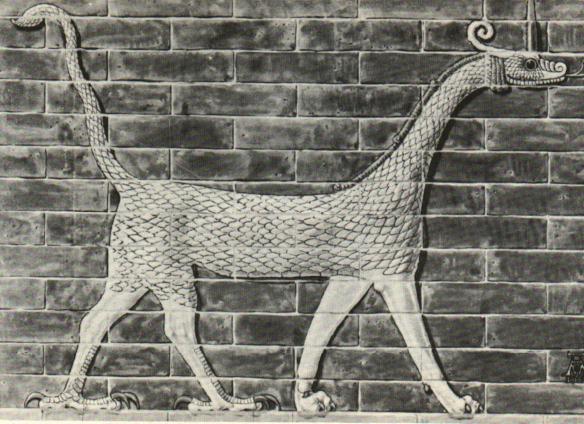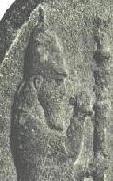Neo-Babylonian Empire (625-539)
 |
| Dragon of Marduk, from the walls of Babylon |
This period has also been called the Chaldean Empire after the fact that Nabopolassar was probably a Chaldean instead of a Babylonian.
Nabopolassar (Nabu-Apla-Usur) (625-605)-His actual name was Nabu-Apla-Usur. He revolted against the Assyrians and made himself king of the Sealand in 626. He then stirred up a revolt in Babylon, which expelled Sin-Shar-Ishkun and he entered the city as the new king. He is assumed to be a Chaldean, but some scholars disagree and think he may have been an Aramean. He waged a seven year war with Assyria in which he captured Nippur and all of Akkad and Sumer. He unsuccessfully laid siege to Ashur in 616. After the Medes invaded Assyria, he moved north and signed an alliance with Cyaxares, which was cemented when Nebuchadrezzar married his grand- daughter. Their united army destroyed Nineveh in 612 and Harran in 609, thus ending the Assyrian Empire. In 613 a tribal revolt was put down, as well as an Assyrian offensive repulsed. He also conquered Elam.
Nebuchadrezzar II (Nabu-Kudduri-Usur) (605-562)-Son of Nabopolassar. His actual name was Nabu-Kudduri-Usur and his name is sometimes spelled Nebuchadnezzar. He was a skilled diplomat, which allowed the Empire to flourish. He enlarged Babylon and built the Hanging Gardens for his Median wife. In 607, while his father was still on the throne, he waged a war along the Euphrates with Egypt. In 605 he conquered Karkemish and overtook and annihilated the fleeing Egyptian army at Hama. He reached the border of Egypt when news of Nabopolassar's death reached him. He raced back to Babylon to not only be crowned, but to discourage any potential revolt. He was forced to wage an almost yearly campaign in Syria-Palestine to quell uprisings. In 604 he destroyed a rebellious Ascalon and in 601 defeated an invading Egyptian army. In 599 he raided the Qedar region of Arabia and in 597 he occupied Jerusalem ending the Judean Kingdom. He had to put down a revolt in 595 and his army suffered serious losses as a result. After a revolt in 587, he destroyed Jerusalem after an 18 month long siege and deported its populace. Another invading Egyptian army was defeated in Phoenicia in 588. Tyre surrendered after a thirteen year siege and he conquered Cilicia in 585. Little is known of the later years of his reign, but he may have invaded Egypt and he did have conflicts with the priests of Marduk.
Amal-Marduk (Evil-Merodach) (562-560)-Son of Nebuchadrezzar. He is called Evil-Merodach in the Old Testament. He ruled in a "lawless and outrageous fashion" and his sister's husband plotted and murdered him.
Neriglissar (Nergal-Shar-Usur) (560-556)-Son-in-law of Nebuchadnezzar. His actual name was Nergal-Shar-Usur. He waged a victorious campaign against a west Cilicain king, one Appuashu of Pirindu. The facts of his death are obscure.
Labasi-Marduk (556)-Son of Neriglissar. He was still young, but he exhibited such signs of wickedness that his friends plotted and later tortured and killed him. He Reigned three months. The plotters then helped to elevate one of their own to the throne.
Nabonidus (Nabu-Na'id) (555-539)-His actual name was Nabu-Na'id. The son of Nabu-Balatsu-Iqbi, a Babylonian noble. The disgruntled priests of Marduk helped him to gain the throne, which they later would regret. He has been called "The Archaeologist on the Throne" because of his interest in ancient ruins. He waged his only offensive war in 552, conquering Edom. He had an almost exclusive devotion to the moon god Sin and tried to promote his worship, which caused conflicts with the priests and unrest amongst the people. This led to an eventual self-imposed exile to the north Arabian oasis of Tema, where he went about building a tiny Babylon. He also built a temple to Sin at Harran, his mother's hometown. Harran had been in Median hands, but Nabonidus wanted it, so he called on the Persians to attack the Medes. The Persians swept through and not only defeated the Medes, they also occupied Cilicia, a Babylonian vassal. He then signed an alliance with Egypt and Lydia, but he could do nothing to prevent the Persian conquest of Lydia. His son acted as regent for the last 10 years, his years in Tema.
a Babylonian noble. The disgruntled priests of Marduk helped him to gain the throne, which they later would regret. He has been called "The Archaeologist on the Throne" because of his interest in ancient ruins. He waged his only offensive war in 552, conquering Edom. He had an almost exclusive devotion to the moon god Sin and tried to promote his worship, which caused conflicts with the priests and unrest amongst the people. This led to an eventual self-imposed exile to the north Arabian oasis of Tema, where he went about building a tiny Babylon. He also built a temple to Sin at Harran, his mother's hometown. Harran had been in Median hands, but Nabonidus wanted it, so he called on the Persians to attack the Medes. The Persians swept through and not only defeated the Medes, they also occupied Cilicia, a Babylonian vassal. He then signed an alliance with Egypt and Lydia, but he could do nothing to prevent the Persian conquest of Lydia. His son acted as regent for the last 10 years, his years in Tema.
Balshezer (Bel-Shar-Usur) (549-539)-Son of Nabonidus. His actual name was Bel-Shar-Usur. He acted as regent will his father went into self-imposed exile. An increasingly influential pro-Persian party hindered his ability to reign and in the end, the people and priesthood refused to support him. Not everybody was ready to accept Persian rule though, and Nabonidus returned to fight. He had Balshezer deploy his troops along the Tigris, but Gobryas, the Babylonian governor of Assyria deserted to the Persians. When the Persians attacked, the people revolted and Nabonidus slaughtered them. Sippar fell to the Persian without a fight and Nabonidus fled. Gobryas entered Babylon unopposed and Nabonidus was arrested when he returned to the city. Meanwhile, Balshezer was killed at the battle of Opis, on the Tigris. The Greek Xenophon says that Nabonidus was killed, but one source does say that Cyrus appointed him governor of Carmenia.
With the fall of Babylon and the end of the Empire, Mesopotamia ceased to be an independent political entity and would, from now on, be ruled by foreign powers. A civilization that had survived for three millennia, and influenced all of its neighbors, was on its last legs.


 a Babylonian noble. The disgruntled priests of Marduk helped him to gain the throne, which they later would regret. He has been called "The Archaeologist on the Throne" because of his interest in ancient ruins. He waged his only offensive war in 552, conquering Edom. He had an almost exclusive devotion to the moon god Sin and tried to promote his worship, which caused conflicts with the priests and unrest amongst the people. This led to an eventual self-imposed exile to the north Arabian oasis of Tema, where he went about building a tiny Babylon. He also built a temple to Sin at Harran, his mother's hometown. Harran had been in Median hands, but Nabonidus wanted it, so he called on the Persians to attack the Medes. The Persians swept through and not only defeated the Medes, they also occupied Cilicia, a Babylonian vassal. He then signed an alliance with Egypt and Lydia, but he could do nothing to prevent the Persian conquest of Lydia. His son acted as regent for the last 10 years, his years in Tema.
a Babylonian noble. The disgruntled priests of Marduk helped him to gain the throne, which they later would regret. He has been called "The Archaeologist on the Throne" because of his interest in ancient ruins. He waged his only offensive war in 552, conquering Edom. He had an almost exclusive devotion to the moon god Sin and tried to promote his worship, which caused conflicts with the priests and unrest amongst the people. This led to an eventual self-imposed exile to the north Arabian oasis of Tema, where he went about building a tiny Babylon. He also built a temple to Sin at Harran, his mother's hometown. Harran had been in Median hands, but Nabonidus wanted it, so he called on the Persians to attack the Medes. The Persians swept through and not only defeated the Medes, they also occupied Cilicia, a Babylonian vassal. He then signed an alliance with Egypt and Lydia, but he could do nothing to prevent the Persian conquest of Lydia. His son acted as regent for the last 10 years, his years in Tema.